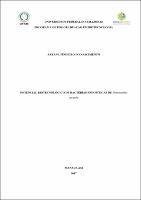| ???jsp.display-item.social.title??? |


|
Please use this identifier to cite or link to this item:
https://tede.ufam.edu.br/handle/tede/5842| ???metadata.dc.type???: | Dissertação |
| Title: | Potencial biotecnológico de bactérias endofíticas de Himatanthus sucuuba |
| ???metadata.dc.creator???: | Nascimento, Aryana Pinheiro do  |
| ???metadata.dc.contributor.advisor1???: | Pereira, José Odair |
| First advisor-co: | Costa Neto, Pedro de Queiroz |
| ???metadata.dc.description.resumo???: | Na busca por alternativas sustentáveis de manejo de doenças, agentes de biocontrole bem como suas relações antagônicas, surgem como fonte importante para o controle biológico aplicado. Neste contexto, o emprego de micro-organismos endofíticos para fins de controle biológico vem sendo amplamente estudado. Eles compreendem, principalmente, fungos e bactérias que habitam o interior das plantas sem causar, aparentemente, danos aos seus hospedeiros. Sua capacidade de biocontrole pode advir de vários mecanismos, como a produção de substâncias deletérias a fitopatógenos ou competindo por espaço e nutrientes. Indiretamente, induzindo resistência sistêmica no hospedeiro ou pela produção de substâncias promotoras de crescimento. Neste sentido, este trabalho visou o isolamento, a caracterização bioquímica e molecular e a busca de bactérias endofíticas que atuem na redução de doenças como a antracnose ou estejam associados à promoção de crescimento vegetal, diminuindo os custos de produção e o impacto ambiental causados pelos insumos químicos. Foram obtidos 416 isolados bacterianos de H. sucuuba, representando 73,08% isoladas da folha, 10,10% do pecíolo e 16,82% da casca. Do total de 308 bactérias analisadas, 48,78% fixaram nitrogênio atmosférico, 83,77% foram capazes de produzir AIA e 96,42% solubilizaram fosfato inorgânico. Quanto ao ensaio de antagonismo in vitro, 219 bactérias foram selecionadas por seleção massal para os testes de cultura pareada e termoestabilidade, no confronto direto 68,49% conseguiram inibir substancialmente o crescimento dos fitopatógenos agindo por antibiose, com diferentes níveis de toxicidade aos patógenos desafiantes, quanto à termoestabilidade 33,79% das linhagens destacaram-se pois conseguiram inibir o crescimento dos fitopatógenos das três hospedeiras tropicais, revelando um grande espectro de ação, e, mostrando que os metabólitos produzidos demonstraram-se termoestáveis, mantendo suas atividades mesmo após a autoclavagem. |
| Abstract: | In the search for sustainable alternatives of disease management, biocontrol agents as well as their antagonistic relations, appear as important source for the applied biological control. In this context, the use of endophytic microorganisms for biological control purposes has been extensively studied. They mainly comprise fungi and bacteria that inhabit the interior of plants without apparently causing damage to their hosts. Their ability to biocontrol can come from several mechanisms, such as the production of deleterious substances to phytopathogens or competing for space and nutrients. Indirectly, inducing systemic resistance in the host or by the production of growth promoting substances. In this sense, this work aimed at the isolation, biochemical and molecular characterization and the search for endophytic bacteria that act to reduce diseases such as anthracnose or are associated with the promotion of plant growth, reducing production costs and the environmental impact caused by the inputs Chemicals. A total of 416 bacterial isolates were obtained from H. sucuuba, representing 73.08% of the leaf, 10.10% of the petiole and 16.82% of the peel. From the total of 308 bacteria analyzed, 48.78% fixed atmospheric nitrogen, 83.77% were able to produce AIA and 96.42% solubilized inorganic phosphate. As for the in vitro antagonistic assay, 219 bacteria were selected by mass selection for the paired culture and thermostability tests. In the direct comparison, 68.49% were able to substantially inhibit the growth of phytopathogens by antibiosis, with different levels of toxicity to the challenging pathogens , With respect to thermostability, 33.79% of the lineages were highlighted because they were able to inhibit the growth of the phytopathogens of the three tropical hosts, revealing a great range of action, and, showing that the metabolites produced proved to be thermostable, maintaining their activities even after Autoclaving. |
| Keywords: | Colletotrichum Controle biológico Promotor de crescimento Bactérias endofíticas |
| ???metadata.dc.subject.cnpq???: | CIÊNCIAS BIOLÓGICAS |
| Language: | por |
| ???metadata.dc.publisher.country???: | Brasil |
| Publisher: | Universidade Federal do Amazonas |
| ???metadata.dc.publisher.initials???: | UFAM |
| ???metadata.dc.publisher.department???: | Instituto de Ciências Biológicas |
| ???metadata.dc.publisher.program???: | Programa de Pós-Graduação em Biotecnologia |
| Citation: | NASCIMENTO, Aryana Pinheiro. Potencial biotecnológico de bactérias endofíticas de Himatanthus sucuuba. 2017. 89 f. Dissertação (Mestrado em Biotecnologia) - Universidade Federal do Amazonas, Manaus, 2017. |
| ???metadata.dc.rights???: | Acesso Aberto |
| ???metadata.dc.rights.uri???: | http://creativecommons.org/licenses/by-nc-nd/4.0/ |
| URI: | http://tede.ufam.edu.br/handle/tede/5842 |
| Issue Date: | 10-Feb-2017 |
| Appears in Collections: | Mestrado em Biotecnologia |
Files in This Item:
| File | Description | Size | Format | |
|---|---|---|---|---|
| Dissertação - Aryana P. Nascimento.pdf | 2.51 MB | Adobe PDF |  Download/Open Preview |
This item is licensed under a Creative Commons License





